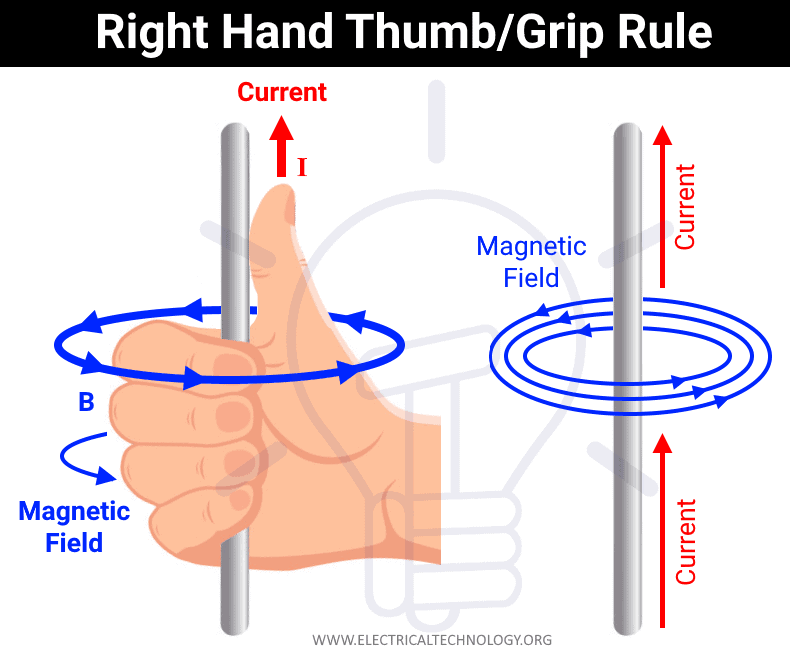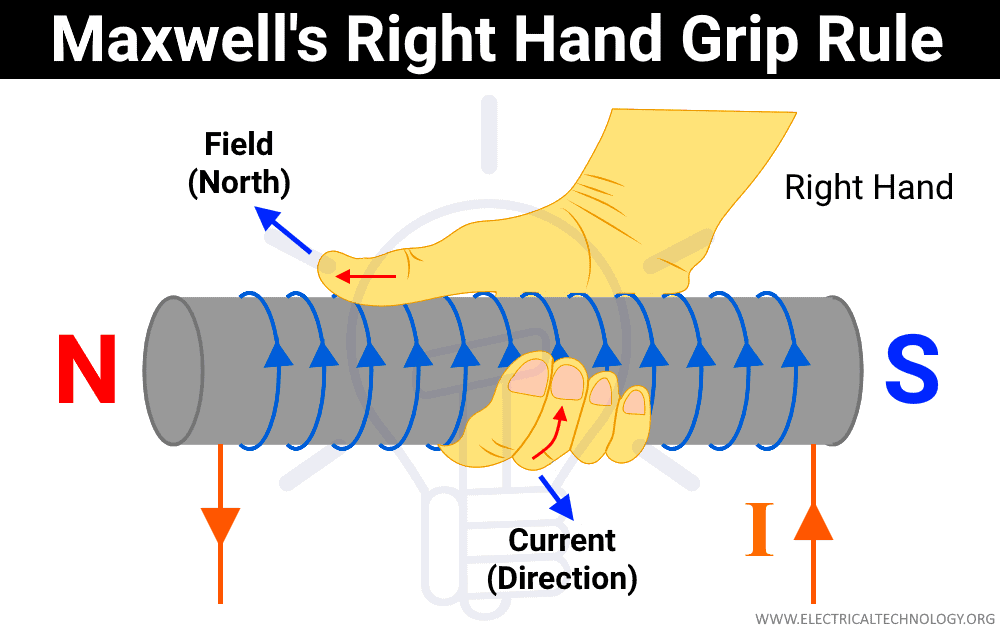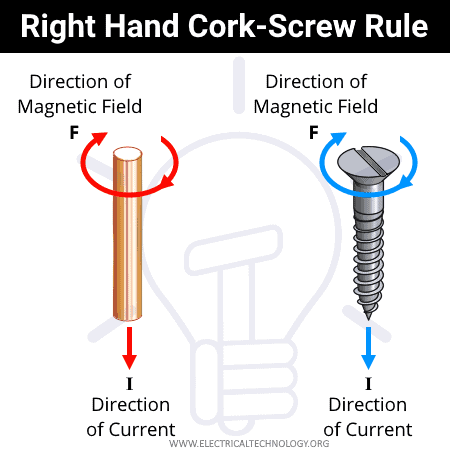Right Hand Grip/Thumb Rule, Corkscrew Rule & End/Clock Rule
Right Hand Thumb Gripping Rule, Corkscrew Rule, Clock Rule or End Rule For Current & Magnetic Field Direction
A Danish physicist Hans Christian Orsted in 1820 discovered the relation between electricity and magnetism which states that “when current flows in a straight conductor, a magnetic field is produced in it. The polarity and density of the magnetic field depends on the direction and amount of current flowing through the conductor”.
In simple words, a current carrying conductor creates a magnetic field around it. The lines of magnetic flux are in the shape of concentric circles and perpendicular on the conductor (at right angle of 90o) as shown in fig. The direction of current and magnetic field can be found by the following rules i.e. right hand gripping rule, the end rule, corkscrew rule, Fleming’s left and right hand rules etc.
Related Posts:
Right Hand Grip Rule or Right Hand Thumb Rule
Also known as Maxwell’s Right Hand Thumb Rule (James Clerk Maxwell – a Scottish scientist and mathematician), Ampere’s Right Hand Grip Rule (Andre Marie Ampere – a French physicist and mathematician and the unit of current is named after him), Coffee Mug Rule, Corkscrew Rule, Right Hand Screw Rule or simple, Right Hand Thumb Rule or Right Hand Grip Rule).
The right hand rule is used to determine the direction of the magnetic field lines and current around a straight current carrying conductor, solenoid or coil inductor.
The right hand thumb or grip rule shows if we hold the current carrying conductor in our right hand so that the thumb stretches to the conductor while the fingers wrapped around it, then the thumb shows the direction of current while the curly fingers shows the direction of magnetic field lines of force.
Right hand rule can also be used for determination of the magnetic field orientation and direction
If you hold the coil or a solenoid in the right hand so that the four fingers curl around the coil or solenoid, then the curly figures show the direction of the current and the thumb represents the North Pole of the coil.
Related Posts:
Corkscrew Rule
Corkscrew rule is also known as wood screw or Maxwell’s corkscrew rule. It is based on corkscrew which is a tool used to open/remove the cork from a bottles).
The direction of magnetic field can also be defined by using the corkscrew rule which states that “If a right handed screw turns in a cork, then the screw tip movement (boring) shows the direction of current while the rotation of the screw shows the magnetic field lines.
Since the threads of a screw are in circular shape, the same is the case for magnetic field lines (which are in circular form). The relation between current and magnetic field is shown in the following fig using cork screw rule.
- Related Post: Lenz’s Law of Electromagnetic Induction
The End Rule or Clock Face Rule
The polarity of a solenoid can also be found by using the Clock rule (also known as the End rule of magnetism).
When an observer looks at the facing end of the solenoid, if current flows in the clockwise direction, the the facing end of the solenoid coil behaves like the South Pole “S” and the second end behaves like the North Pole “N”.
Similarly, When the observer sees at the facing end of the coil, if current flows in the anticlockwise direction, then the facing end of the coil behaves like a North Pole “N” and the second end behaves like the South Pole “S”.
Fleming’s Left & Right Hand Rules
The direction of flux lines of magnetic field, motion of the conductor and induced EMF and current can be found by Fleming’s left hand and right hand rules which we have discussed in the previous post.
Related Posts:
- Kirchhoff’s Current & Voltage Law (KCL & KVL) | Solved Example
- Ohm’s Law with Simple Explanation
- Formula & Equations for Ohm’s, Kirchhoff’s & Coulomb’s Laws
- Electric & Magnetic Flux, Density & Field Intensity Formulas
- Norton’s Theorem. Easy Step by Step Procedure with Example
- Thevenin’s Theorem. Step by Step Procedure with Solved Example











Please check figure shown for Maxwell right hand grip rule for winding wound